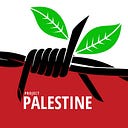Why watermelons are a symbol of Palestinian political protest
Where it is a crime to wave
the flag of Palestine in Palestine,
watermelon halves are raised
against Israeli occupation troops
for the red, black, white, green
of Palestine. Forever.
— Excerpt from ‘Ode to the Watermelon’ by Aracelis Girmay
‘يا من زَاوج الشمس بالماء،
ونادت بدايتك الطيورإلى الارض.
وفي فلسطين،
حيث جُرّم علم فلسطين في فلسطين،
ترفع انصاف البطيخ في وجه الاحتلال الاسرائيلي
في سبيل الأحمر والأسود والأبيض والأخضر الفلسطيني.
الى الأبد،’
— مقطتف من ‘قصيدة البطيخ’ للكاتبة أرساليس غيرماي
“Today marks 33 years since the first Intifada.
In the years preceding the Intifada, artwork using the colours of the Palestinian flag was banned. In their insistence on expressing their national identity, Palestinians would carry around a sliced watermelon, representing the colours of the flag.
‘Palestinian Flag’ (2013) by Khaled Hourani uses the watermelon as a metaphor for the once forbidden flag.”
Haaretz (Jan 2018) reported that Jawad Siyam, a well-known Palestinian activist from East Jerusalem’s Silwan neighborhood, was arrested by Israeli soldiers for holding balloons in the colors of the Palestinian flag.
The following is excerpt from an article published in Vice, Oct 3, 2015, talking about Israel’s obsesion in fighting anything that has Palestinian colours including Watermelon…
In the years following the Six Day War in 1967, it became a crime to raise a Palestinian flag in Israeli-controlled Gaza and the West Bank. To subvert the ban on the national colors, it is said that Palestinians would carry sliced watermelons through the region in a sign of protest. In October of 1993, just weeks after Israel and the Palestinian Liberation Organization signed the Oslo Accords in Washington, DC, The New York Times reported that young men were once detained for holding watermelon halves in the Gaza Strip. An editor’s note several months later stated that the paper could not ultimately confirm the claims, but that an Israeli government official also could not deny that such arrests had taken place.
Similarly, prominent Palestinian artists have stated over the years that they risked imprisonment for simply painting depictions of watermelons, as well as other images (like poppy seed plants) that might have incorporated the national colors. Australia’s daily newspaper, The Age, also reported that the watermelon was used as a symbol of the Second Intifada — or Palestinian uprising — in 2000.
“The Israelis were extremely harsh in cracking down on any manifestation of Palestinian nationalism, and the more symbolic and the more visible, the angrier they would get,” explains Rashid Khalidi, the Edward Said Professor of Arab Studies at Columbia University and the editor of the Journal of Palestine Studies. “Palestine didn’t exist, the Palestinians didn’t exist, and anybody who claimed otherwise was in trouble.”
With tensions heightened — and an Israeli anti-terrorism bill designed to ban the Palestinian flag less than a year in the past — it remains unclear if the red, black, green, and white of the watermelon will once again become an image of political subversion in the Middle East.
“It’s a symbol of the existence of a national group and sort of the most striking,” Khalidi says of the importance of the Palestinian colors. “I mean, how could you express your Palestinian identity more visibly than by raising or waiving or painting a flag?”
